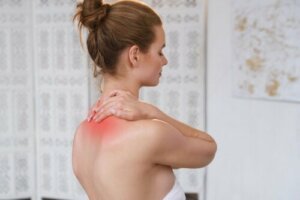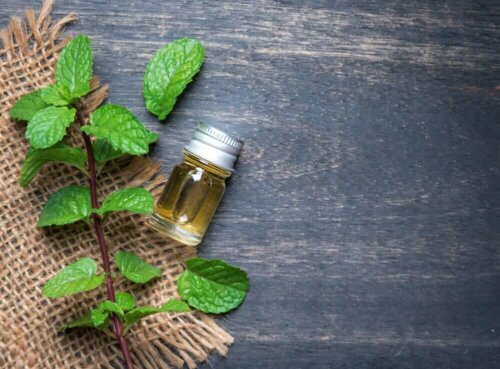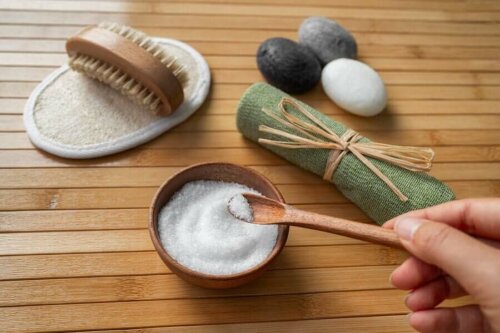11 muscle relaxants that come from nature


Reviewed and approved by the doctor Maricela Jiménez López
Muscle relaxants are medications used to combat muscle tension, spasms, and other common ailments that often affect the range of motion of areas such as the back, neck, hips, etc. What are natural muscle relaxants?
In fact, there’s a wide variety of naturally occurring ingredients that provide a similar effect as conventional muscle relaxants. However, they aren’t a substitute for the medication, and their effect tends to be more moderate. Let’s take a detailed look at 11 options you can try.
Muscle pain: causes and treatment
Muscular ailments can be caused by an injury, muscular overexertion, or illness, among other factors. Due to this, once the pain is perceived, one must be attentive to its level of severity and other associated symptoms.
If necessary, it’s important to consult a doctor to receive a more accurate diagnosis and, based on this, the appropriate treatment. For such purposes, the usual treatments include:
- Analgesics and anti-inflammatories
- Hot and cold compresses.
- Physiotherapy
- Relaxing massages (done by a professional).
- Acupuncture.
11 natural muscle relaxants
Natural muscle relaxants can be used for pain relief when there are no other serious injuries. In other words, they’re ideal for pain caused by exercise, incorrect movement, or overexertion. Are you going to try them?
1. Peppermint oil
Peppermint oil is one of the natural products that can help you to relax your muscles if they’re tense and rigid. According to information in the International Journal of Molecular Sciences, topical application of this oil can help reduce pain.
It has anti-inflammatory and analgesic properties. These reduce pain and swelling, at least temporarily.

Ingredients
- 10 drops of peppermint essential oil
- 2 tbsp. of coconut oil (40 g.)
Instructions
- Firstly, mix the oils together.
- Then, moisten the palms of your hands with a small amount of peppermint oil; rub it on the muscles you want to relax.
- Be sure to massage them for at least 5 minutes to get good results.
Read also: 6 Body Parts You Should Massage
2. Valerian
Thanks to its calming and anti-inflammatory effects, you can get benefits from both Valerian oil and tea. It can have a positive effect on muscle stress. Its consumption and direct application can contribute to muscle relaxation, as indicated by a study published in the Journal of Traditional and Complementary Medicine.
Ingredients
- 1 tsp. of valerian (7 g.)
- 1 cup of water (250 ml.)
Instructions
- Firstly, pour the valerian into the cup of boiling water, and let it steep.
- When it’s ready, pass it through a sieve.
- Finally, drink a cup and relax.
Note: This plant can cause drowsiness.
3. Epsom salts for muscle tension
Baths with Epsom salts are perfect for relaxing your tired muscles. This is thanks to their high levels of magnesium. As detailed in a publication at the National Center for Biotechnology Information, magnesium helps mitigate hypersensitivity to pain and plays an important role in pain management.

Ingredients
- 1/2 c. of Epsom salts (100 g.)
Instructions
- Firstly, add half a cup of Epsom salts to water in your tub and submerge your body for twenty minutes.
- Use this treatment before sleeping to guarantee good rest.
4. Chamomile
Chamomile is known in the natural medicine world for its digestive and emollient properties. This herb is also a natural solution for relieving pain and muscular swelling.
According to research published in Molecular Medicine Reports, it has antispasmodic and anti-inflammatory properties. These encourage muscle relaxation. This is especially true when muscle tension is due to stress. For this reason, it is considered a good muscle relaxant.
Ingredients
- 1 tbsp. of dried chamomile (15 g.)
- 1 cup of water (250 ml.)
Instructions
- Firstly, prepare a cup of chamomile tea by adding the dried plant to the hot water.
- Then, drink a cup of chamomile tea two or three times per day.
- In addition, optionally apply it as a compress in the areas of pain.
5. Arnica oil
Arnica has a chemical compound called thymol. Because of the way it works, it’s perfect for relieving muscle pain. However, its effectiveness as a muscle relaxant hasn’t been proven to date.
Applying its oil directly creates a gentle heating sensation that reduces tension.

Ingredients
- 1 tsp. of arnica oil (10 ml)
- 2 tbsp. of coconut oil (40 ml)
Instructions
- Firstly, put several drops of arnica oil or gel on the tense muscles and massage them for five minutes.
- Then, repeat this treatment two times per day if you think it’s necessary.
6. Cayenne pepper
Its spicy flavor can be unbearable for some people. However, cayenne pepper is a good solution for muscle pain.
It has an active substance called capsaicin. This gives it anti-inflammatory and pain-relieving properties, according to a study published in Pain and Therapy.
Instructions
- Firstly, add small amounts of cayenne pepper to your smoothies and teas.
- Additionally, get cayenne pepper and use it to massage your tired muscles.
Check out: How to Use Salt as a Beauty Treatment
7. Passionflower
Passionflower is a very well-known plant in natural medicine. This isn’t just because it helps to control your nerves. It also works as an anti-inflammatory and relaxes your muscles.
According to a study published in the Journal of Ethnopharmacology, it has phytosterols and flavonoids. These two substances have antioxidant effects that reduce oxidative stress. They also help to control problems like anxiety and insomnia.
Ingredients
- 1 tsp. of passionflower (10 g.)
- 1 cup of water (250 ml)
Instructions
- Firstly, pour the passionflower into a cup of boiling water, and let it rest for 10 minutes.
- Drink the tea before going to sleep.
- As another option, soak an absorbent cloth in the hot tea and apply it as a compress on the painful area.
8. Hypericum oil
Hypericum, also known as St. John’s wort, is a species of the Hypericaceae family. Consumed orally, it is said to provide benefits for the nervous system, helping in cases of anxiety and depression; topically, it has healing, antiseptic, antibacterial, and anti-inflammatory properties.
Ingredients
- 50 g of hypericum flowers and leaves
- 250 cm3 of almond oil
Preparation
- Chop the flowers and leaves.
- Put them in a glass container.
- Add the almond oil.
- Leave for 20 days in a place where it does not receive light or heat.
- Then, filter it.
Recommendations
- Apply once or twice a day.
- Do not use it if you’re going to be exposed to the sun.
- Since this preparation takes time, it’s best always to have it ready and on hand.
9. Rosemary oil
Rosemary (Salvia rosmarinus) is used for various purposes, related to aesthetics and health. It’s considered to make hair grow stronger. However, it’s also a natural muscle relaxant, helping to treat and prevent contractures.
Ingredients
- A small bundle of rosemary sprigsOlive oil (750ml)
How to prepare it
- Wash the rosemary.
- Let it dry well.
- Put it completely in a bottle.
- Add the olive oil.
- Cover and store in a closed and dark place.
- Let it soak for a month.
- After this time, strain the oil, and it’s ready to be used.
How to use it
- Rub or massage into the sore area.
10. Devil’s claw
The devil’s claw is another herbaceous plant. It’s native to southern Africa. It is considered to have analgesic and anti-inflammatory properties, which makes it a natural muscle relaxant.
You can find extracts of this plant in stores, both in liquid and in capsules. The recommendation is to consume 400 to 800 milligrams a day.
According to research, its efficacy has been proven in clinical trials for the treatment of mild to moderate muscle pain in the shoulder, neck, and lower back.
It’s contraindicated when there’s a gastroduodenal ulcer. It’s also not recommended during pregnancy and when breastfeeding. It’s believed that in high doses, it can interfere with antiarrhythmic, hypotensive, and hypertensive drugs. It can cause diarrhea in sensitive people.
11. Lavender
Lavender has a pleasant smell, which is why it is widely used in aromatherapy. In addition, it has a sedative effect.
How to use it
There are two ways to use lavender to help relax muscle tension:
- Add lavender flowers or oil when taking a bath, immersing the affected part.
- Apply lavender oil and carefully rub the area; this can be done once or twice a day.
When to go to the doctor?
The aforementioned remedies are useful as natural muscle relaxants for minor ailments. However, it’s essential to keep in mind that they’re not a cure for pain, and in some cases, there’s a lack of evidence on their safety and efficacy. Therefore, if the pain is severe or persistent, it’s best to see a doctor.
All cited sources were thoroughly reviewed by our team to ensure their quality, reliability, currency, and validity. The bibliography of this article was considered reliable and of academic or scientific accuracy.
- Anand, P., & Bley, K. (2011). Topical capsaicin for pain management: therapeutic potential and mechanisms of action of the new high-concentration capsaicin 8% patch. British journal of anaesthesia, 107(4), 490–502. Recuperado de: https://doi.org/10.1093/bja/aer260
- Aradmehr, M., Azhari, S., Ahmadi, S., & Azmoude, E. (2017). The Effect of Chamomile Cream on Episiotomy Pain in Primiparous Women: A Randomized Clinical Trial. Journal of caring sciences, 6(1), 19–28. Disponible en: https://doi.org/10.15171/jcs.2017.003
- Borges, R. S., Ortiz, B. L. S., Pereira, A. C. M., Keita, H., & Carvalho, J. C. T. (2019). Rosmarinus officinalis essential oil: A review of its phytochemistry, anti-inflammatory activity, and mechanisms of action involved. Journal of ethnopharmacology, 229, 29–45. Disponible en: https://doi.org/10.1016/j.jep.2018.09.038
- Caudal, D., Guinobert, I., Lafoux, A., Bardot, V., Cotte, C., Ripoche, I., Chalard, P., & Huchet, C. (2017). Skeletal muscle relaxant effect of a standardized extract of Valeriana officinalis L. after acute administration in mice. Journal of traditional and complementary medicine, 8(2), 335–340. Recuperado de: https://doi.org/10.1016/j.jtcme.2017.06.011
- Fattori, V., Hohmann, M. S., Rossaneis, A. C., Pinho-Ribeiro, F. A., & Verri, W. A. (2016). Capsaicin: Current Understanding of Its Mechanisms and Therapy of Pain and Other Pre-Clinical and Clinical Uses. Molecules (Basel, Switzerland), 21(7), 844. Recuperado de: https://doi.org/10.3390/molecules21070844
- Galeotti, N., Vivoli, E., Bilia, A. R., Vincieri, F. F., & Ghelardini, C. (2010). St. John’s Wort reduces neuropathic pain through a hypericin-mediated inhibition of the protein kinase Cgamma and epsilon activity. Biochemical pharmacology, 79(9), 1327–1336. Disponible en: https://doi.org/10.1016/j.bcp.2009.12.016
- Gröber, U., Werner, T., Vormann, J., & Kisters, K. (2017). Myth or Reality-Transdermal Magnesium?. Nutrients, 9(8), 813. Disponible en: https://doi.org/10.3390/nu9080813
- Hyun-Jung, S., Na, H. S., & Do, S. H. (2020). Magnesium and Pain. Nutrients, 12(8), 2184. Recuperado de: https://www.mdpi.com/2072-6643/12/8/2184
- Higashi, Y., Kiuchi, T., & Furuta, K. (2010). Efficacy and safety profile of a topical methyl salicylate and menthol patch in adult patients with mild to moderate muscle strain: a randomized, double-blind, parallel-group, placebo-controlled, multicenter study. Clinical therapeutics, 32(1), 34–43. Disponible en: https://doi.org/10.1016/j.clinthera.2010.01.016
- Olajide O. A. (2009). Inhibitory effects of St. John’s Wort on inflammation: ignored potential of a popular herb. Journal of dietary supplements, 6(1), 28–32. Disponible en: https://doi.org/10.1080/19390210802687247
- Pan, R., Tian, Y., Gao, R., Li, H., Zhao, X., Barrett, J. E., & Hu, H. (2012). Central mechanisms of menthol-induced analgesia. The Journal of pharmacology and experimental therapeutics, 343(3), 661–672. Recuperado de: https://doi.org/10.1124/jpet.112.196717
- Park, S. H., Sim, Y. B., Lee, J. K., Kim, S. M., Kang, Y. J., Jung, J. S., & Suh, H. W. (2011). The analgesic effects and mechanisms of orally administered eugenol. Archives of pharmacal research, 34(3), 501–507. Disponible en: https://doi.org/10.1007/s12272-011-0320-z
- Soprano, S. E., Hennessy, S., Bilker, W. B., & Leonard, C. E. (2020). Assessment of Physician Prescribing of Muscle Relaxants in the United States, 2005-2016. JAMA network open, 3(6), e207664. Recuperado de: https://doi.org/10.1001/jamanetworkopen.2020.7664
- Shirzad-Siboni, V., Nobahar, M., & Ghorbani, R. (2022). Effect of chamomile oil on the intensity of nonspecific low back pain in prehospital emergency technicians. The American Journal of Emergency Medicine, 60, 200-203. Recuperado de: https://www.sciencedirect.com/science/article/abs/pii/S0735675722004041
- Srivastava, J. K., Shankar, E., & Gupta, S. (2010). Chamomile: A herbal medicine of the past with bright future. Molecular medicine reports, 3(6), 895–901. Disponible en: https://doi.org/10.3892/mmr.2010.377
- Smith, A. G., Miles, V. N., Holmes, D. T., Chen, X., & Lei, W. (2021). Clinical Trials, Potential Mechanisms, and Adverse Effects of Arnica as an Adjunct Medication for Pain Management. Medicines (Basel, Switzerland), 8(10), 58. Disponible en: https://doi.org/10.3390/medicines8100058
- World Health Organization. (2022). Musculoskeletal health. Recuperado de: https://www.who.int/news-room/fact-sheets/detail/musculoskeletal-conditions [Consultado el 2 de febrero de 2023].
- Zare, A., Khaksar, Z., Sobhani, Z., & Amini, M. (2018). Analgesic Effect of Valerian Root and Turnip Extracts. World journal of plastic surgery, 7(3), 345–350. Recuperado de: https://doi.org/10.29252/wjps.7.3.345
This text is provided for informational purposes only and does not replace consultation with a professional. If in doubt, consult your specialist.








